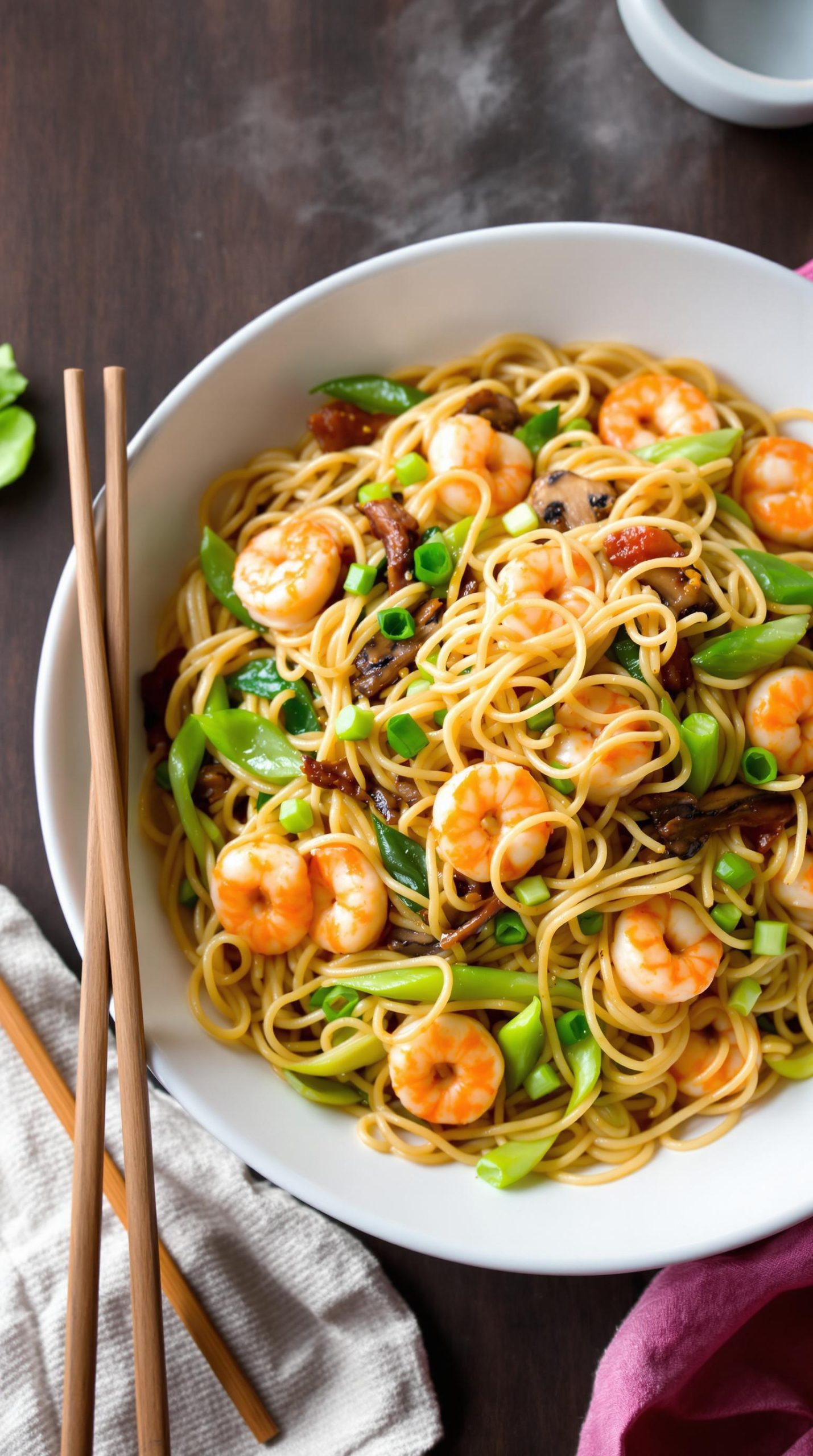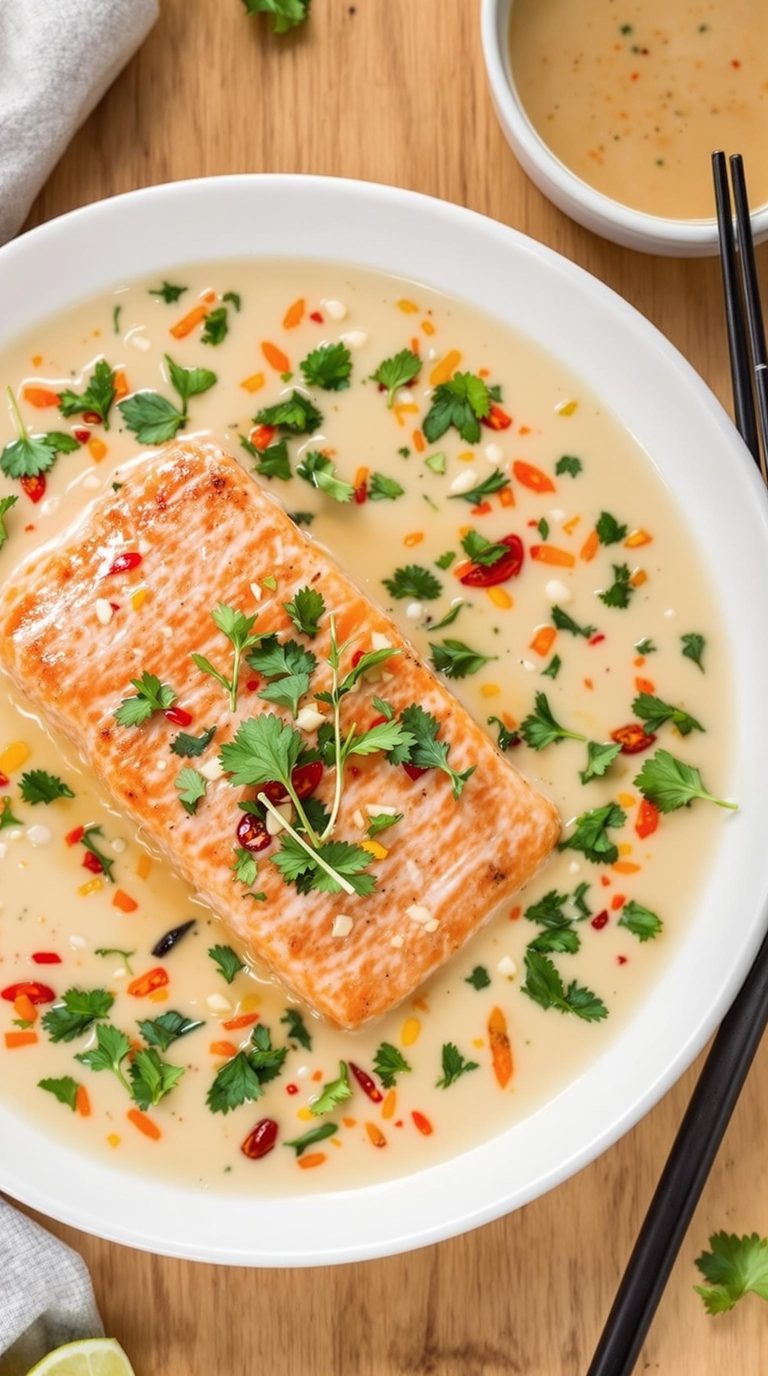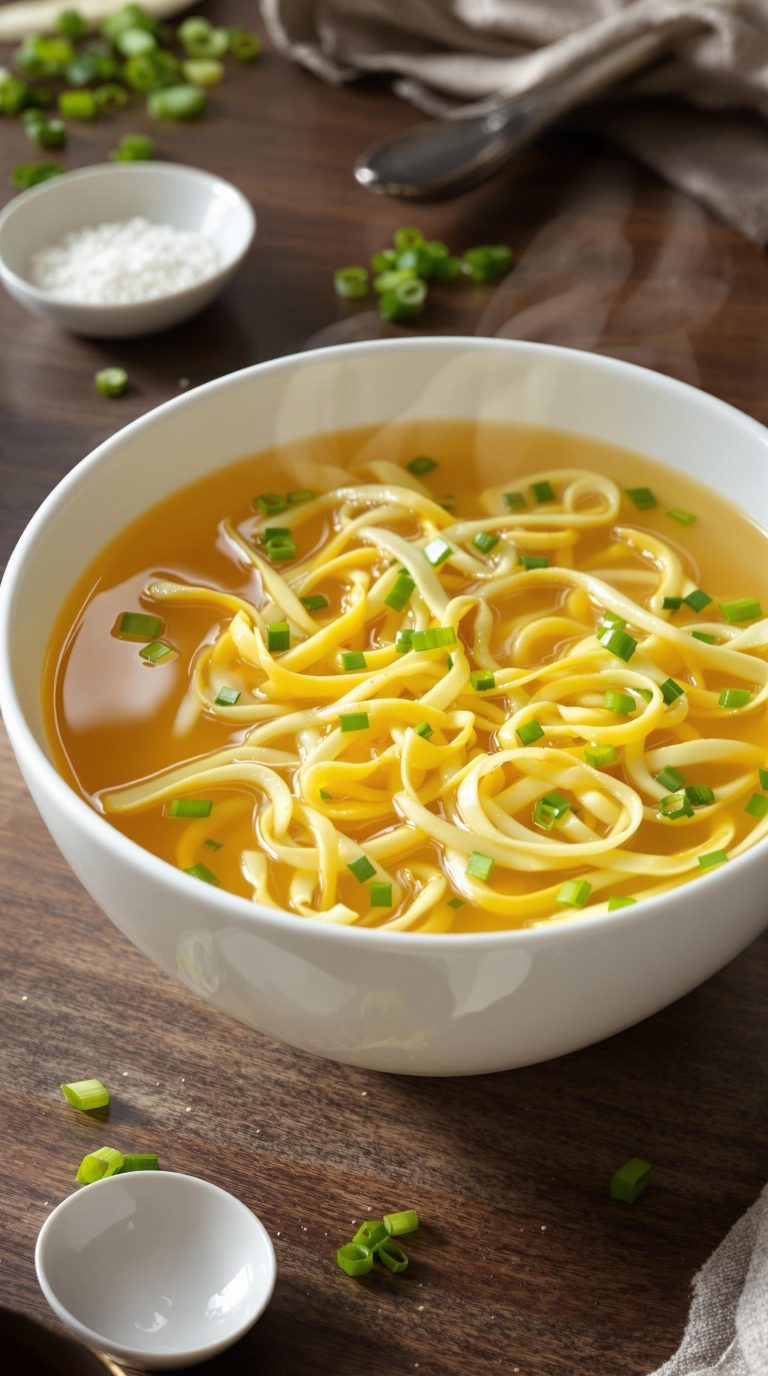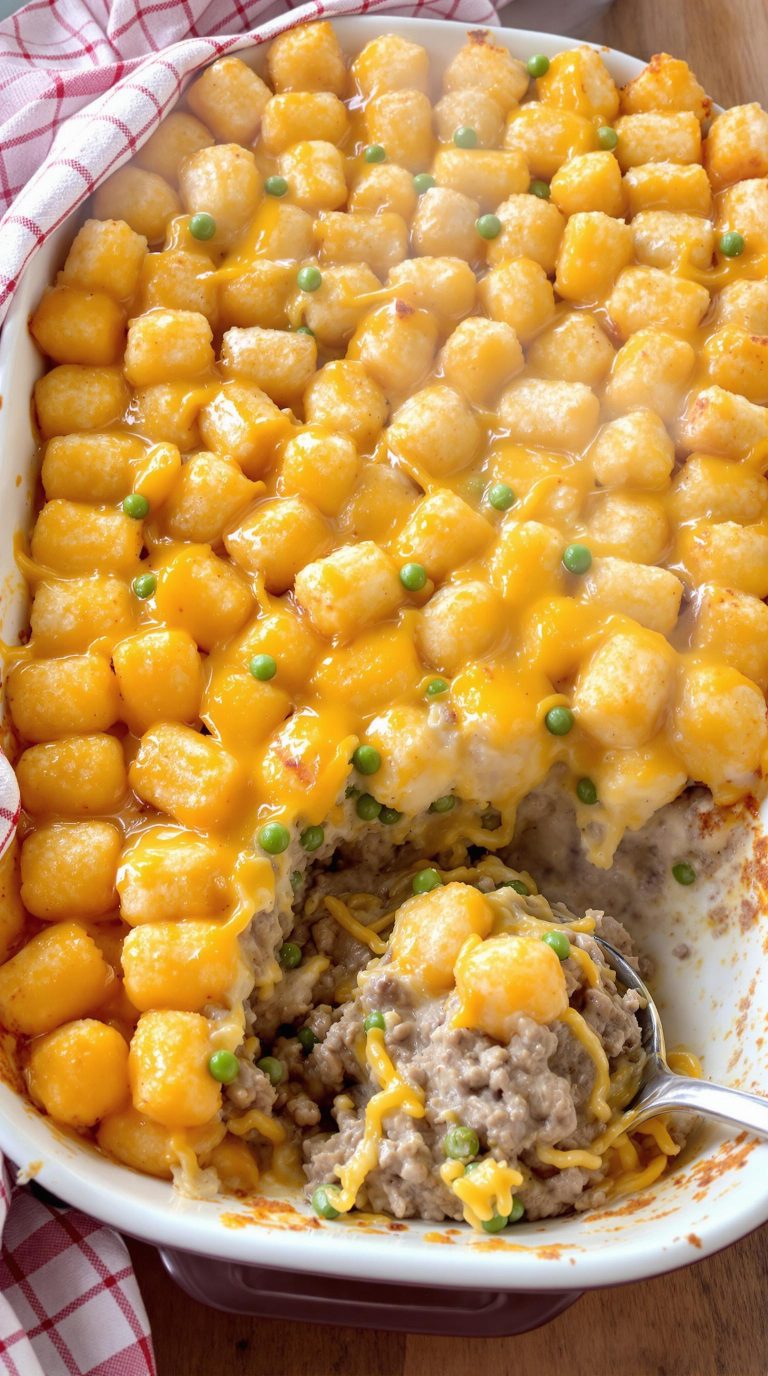Why You’ll Love this Fresh Shrimp Lo Mein
When you’re craving a restaurant-quality Asian dish that doesn’t require hours in the kitchen, this Fresh Shrimp Lo Mein is exactly what you need. I’m obsessed with how the tender shrimp pairs perfectly with crisp vegetables and those slurpable egg noodles, all coated in a savory oyster sauce.
What makes this recipe special? The balance of textures—crunchy pea pods, silky bok choy, meaty mushrooms—plus that magical combination of ginger and garlic. The barbecued pork adds an extra layer of flavor you won’t get in basic lo mein recipes. Can you believe it comes together in about 30 minutes?
What Ingredients are in Fresh Shrimp Lo Mein?
Making this restaurant-worthy Shrimp Lo Mein at home requires fresh ingredients and a few Asian pantry staples you’ll reach for again and again.
I’m always amazed at how these simple ingredients transform into something so flavorful when quickly stir-fried together. The key to authentic lo mein is including a variety of textures, from the tender shrimp to the crisp vegetables, all brought together with that savory, slightly sweet sauce that clings perfectly to the noodles.
- 3/4 pound fresh or frozen shrimp, peeled and deveined
- 8 ounces Chinese egg noodles
- 8 ounces bok choy (about 4 large stalks)
- 6 ounces pea pods (snow peas)
- 4 ounces mushrooms
- 2 green onions
- 1 cup barbecued pork, sliced
- 1 teaspoon fresh ginger, chopped
- 1 teaspoon garlic, finely chopped
- 1/4 cup oyster sauce
- 1 cup chicken broth
- 4 tablespoons vegetable oil (divided)
- 3 tablespoons cornstarch (plus 1 teaspoon for marinating shrimp)
- 3 tablespoons cold water
- 1/2 teaspoon sesame oil
- 1 1/4 teaspoons salt (divided)
- 1/8 teaspoon white pepper
When shopping for this recipe, look for fresh shrimp if possible, though frozen works perfectly fine too.
The barbecued pork (char siu) can usually be found at Asian markets or can be substituted with leftover roast pork in a pinch.
For the noodles, traditional Chinese egg noodles give the most authentic texture, but you could substitute with linguine if needed.
Fresh vegetables make all the difference here—bright green bok choy and crisp snow peas not only add beautiful color but also provide that signature crunch that makes lo mein so satisfying.
How to Make this Fresh Shrimp Lo Mein
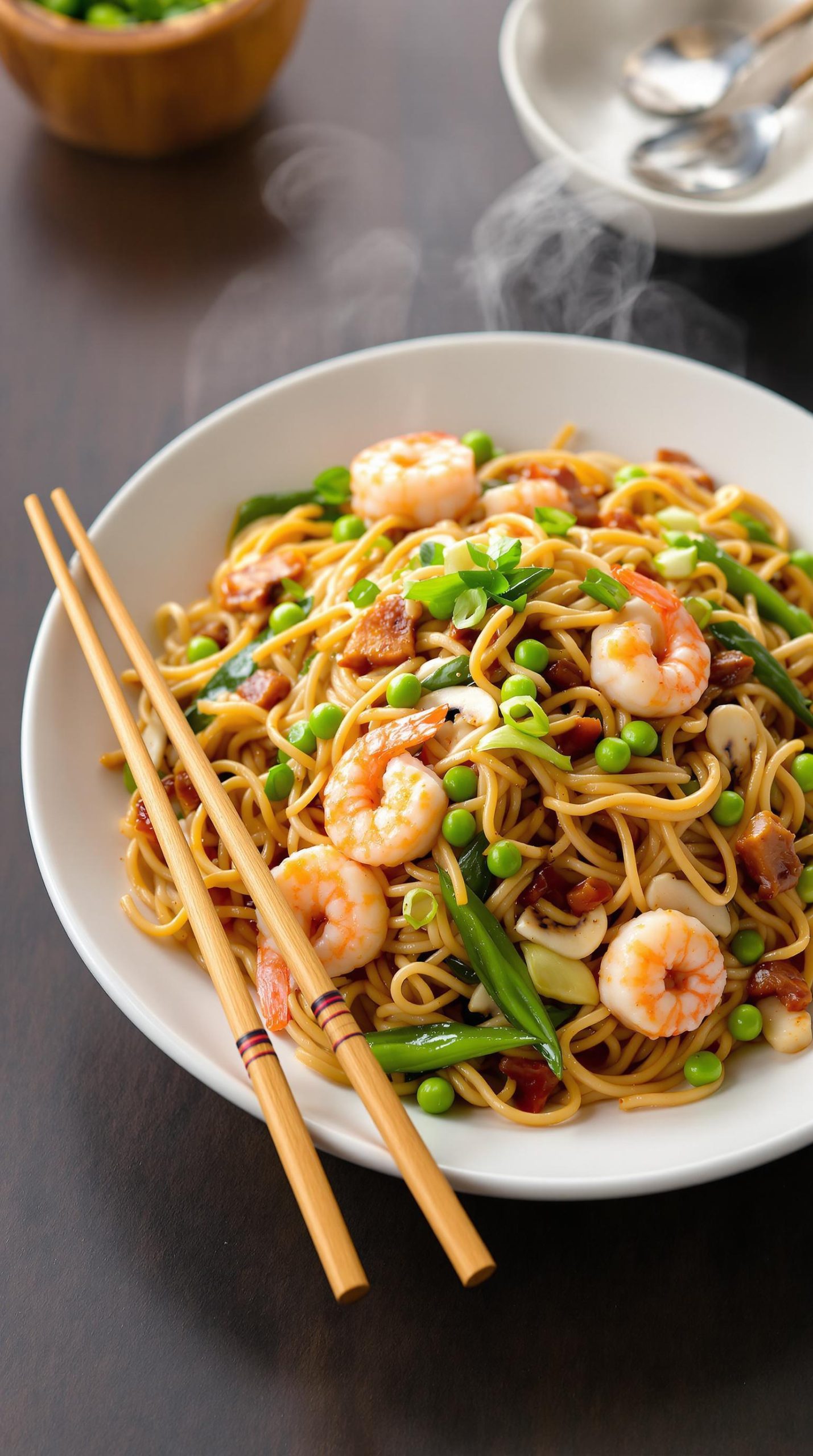
Making this shrimp lo mein starts with properly preparing the shrimp. Peel your 3/4 pound of shrimp (if frozen, peel them under cold running water), then make a shallow cut down the back to remove the sand vein. Cut each shrimp lengthwise into halves and marinate them in a mixture of 1 teaspoon cornstarch, 1/2 teaspoon sesame oil, 1/4 teaspoon salt, and 1/8 teaspoon white pepper for about 20 minutes in the refrigerator. This quick marinade makes all the difference, giving the shrimp a velvety texture and helping them retain moisture during the high-heat cooking.
While the shrimp marinates, prep your vegetables and get your noodles ready. Separate the bok choy leaves from stems, cutting leaves into 2-inch pieces and slicing stems diagonally into 1/4-inch pieces—keeping them separate since they cook at different rates. Blanch 6 ounces of pea pods in boiling water for just 1 minute before plunging them into cold water (this keeps that gorgeous bright green color).
Slice 4 ounces of mushrooms and cut 2 green onions into 2-inch pieces. Now for the noodles: boil 8 ounces of Chinese egg noodles for about 5 minutes until soft and separated, then drain and keep warm in a low oven. I find having everything prepped before I start stir-frying makes the process so much less stressful.
When everything’s prepped, the stir-frying happens quickly. Heat your wok until it’s smoking hot, then add 2 tablespoons vegetable oil and stir-fry the marinated shrimp with 1 teaspoon chopped ginger and 1 teaspoon chopped garlic until the shrimp turn pink. Remove the shrimp, add another 2 tablespoons oil, and stir-fry the bok choy stems for a minute before adding the leaves, mushrooms, 1/4 cup oyster sauce, and 1 teaspoon salt. For perfect results, use a high end thermometer to ensure your wok reaches the ideal temperature for stir-frying.
After another minute of stir-frying, pour in 1 cup of chicken broth, bring to a boil, and thicken with a mixture of 3 tablespoons cornstarch and 3 tablespoons water. Finally, return the shrimp to the wok along with the pea pods, green onions, and 1 cup sliced barbecued pork.
For those who enjoy making homemade Chinese sausage to add to this dish, a premium meat grinder can help you create authentic flavors that elevate this recipe.
After a quick 30-second stir to incorporate everything, serve this colorful, aromatic mixture over your warm noodles. The sauce should perfectly coat each strand, creating that authentic restaurant-quality lo mein we all crave.
Fresh Shrimp Lo Mein Substitutions and Variations
Looking for ways to customize this classic shrimp lo mein recipe? I’ve got plenty of options for you.
Swap shrimp for chicken, beef, or tofu if seafood isn’t your thing. Don’t have bok choy? Regular cabbage works in a pinch. Mushroom varieties like shiitake or oyster can replace button mushrooms for deeper flavor.
For a vegetarian version, skip the pork and shrimp, double the veggies, and use vegetable broth instead.
Spice lovers can add red pepper flakes or sriracha. No egg noodles? Rice noodles or even spaghetti can stand in.
Trust me, lo mein is forgiving—make it your own!
What to Serve with Fresh Shrimp Lo Mein
While shrimp lo mein shines as a complete meal on its own, pairing it with the right side dishes elevates your dining experience to restaurant quality.
I recommend serving crispy egg rolls or light spring rolls alongside your noodles—that perfect crunch complements the tender shrimp beautifully. A simple cucumber salad with rice vinegar dressing adds invigorating contrast to the rich flavors.
Want something warm? Try garlic bok choy or Chinese broccoli for extra greens. Don’t forget hot tea to cleanse the palate between bites.
These pairings create balance. The sweet, salty, crunchy, and fresh elements working together? Pure magic.
Final Thoughts
Mastery of shrimp lo mein brings a special kind of satisfaction to home cooking.
There’s something magical about watching those plump shrimp, vibrant vegetables, and silky noodles come together in your very own kitchen. The balance of flavors—savory oyster sauce, aromatic ginger and garlic—creates a restaurant-quality dish you can proudly serve any night of the week.
While it might seem intimidating at first, haven’t you found that breaking down complex recipes into manageable steps makes them surprisingly achievable?
Trust the process, enjoy the rhythmic chopping and stirring, and remember: cooking isn’t about perfection, it’s about creating moments around your table.
For a similar Asian noodle experience, try making Japanese yakisoba noodles with convenient substitutes like packaged ramen and frozen vegetable mixes.
